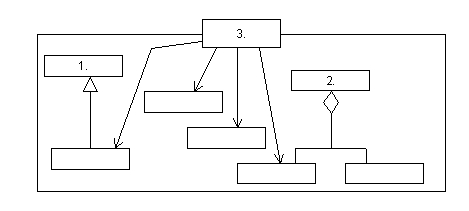 |
| 1 |  | 
Which of the following is not an argument for reuse? |
|  | A) | If some of the requirements of a project can be met by existing components then the time spent developing those components can be saved. |
|  | B) | If components that have been used and tested in another application can be reused then the time spent testing and quality assuring the components can be saved. |
|  | C) | Reusing components allows developers to maintain their high salaries by claiming to have developed software that has in fact been developed by someone else. |
|
|
 |
| 2 |  | 
Which of the following is cited as a reason for the failure of object-oriented systems to have achieved the expected levels of reuse? |
|  | A) | Organizations plan for reuse too late. The architecture of a system needs to be designed to support reuse and the organization needs to be structured to support reuse. |
|  | B) | Reuse does not actually work. There are no systems that are enough like others to benefit from the reuse of components. |
|  | C) | Reuse only works for languages like C and Fortran in which libraries of reusable functions and procedures can be developed. |
|
|
 |
| 3 |  | 
Which of the following is not a standard that helps to support reusable components? |
|  | A) | SOAP (Simple Object Access Protocol). |
|  | B) | CORBA (Common Object Request Broker Architecture). |
|  | C) | ORCA (Object Reusable Component Architecture). |
|
|
 |
| 4 |  | 
Which of the following kinds of organization is most likely to benefit from developing a reuse-driven software development process, according to Jacobson et al.? |
|  | A) | Organizations producing hardware products with embedded software. |
|  | B) | Small software companies producing one-off products. |
|  | C) | Government departments developing software in-house. |
|
|
 |
| 5 |  | 
Jacobson et al. suggest there are six stages that organizations go through in developing a culture of reuse. |
|  | A) | Which of the following is their list of stages?
Business; user; data; solution; component; repository. |
|  | B) | None; informal code reuse; black-box code reuse; managed workproduct reuse; architected reuse; domain-specific reuse-driven organization. |
|  | C) | Heroic individual reuse; informal code reuse; organized group code reuse; architecture-driven reuse; component-driven reuse; repository-based reuse. |
|
|
 |
| 6 |  | 
What do Allen and Frost regard as central to their model for the development of reusable code components? |
|  | A) | Java. |
|  | B) | The Façade pattern. |
|  | C) | A repository. |
|
|
 |
| 7 |  | 
What are Apperly et al.’s three workflows to support reuse? |
|  | A) | Supply, consume and manage. |
|  | B) | Build, store and reuse. |
|  | C) | Develop, repose, reuse. |
|
|
 |
| 8 |  | 
Which of the following is a good definition of a reusable component? |
|  | A) | A type class or other workproduct that has been specifically engineered to be reusable. |
|  | B) | Anything that appears in a component diagram. |
|  | C) | A class or abstract superclass designed to be reused through inheritance. |
|
|
 |
| 9 |  | 
Why are classes an inappropriate level at which to try to achieve reuse? |
|  | A) | Attributes and associations of classes often couple them to other classes. |
|  | B) | Objects not classes are suitable for reuse, as they are the things that are used in real systems. |
|  | C) | Interfaces rather than classes should be reused, and then classes developed to implement them. |
|
|
 |
| 10 |  | 
Which of the following analogies is used by Allen and Frost? |
|  | A) | Hiding reusable components behind a façade.. |
|  | B) | Sowing and harvesting reusable components. |
|  | C) | Cloning reusable components from existing systems. |
|
|
 |
| 11 |  | 
What do Jacobson et al. recommend in their description of a Reuse-driven Software Engineering Business? |
|  | A) | Designing an architecture to support reuse from the start. |
|  | B) | Setting up a department to check newly developed software for reusable components. |
|  | C) | 50% of all elements of a system should be reused. |
|
|
 |
| 12 |  | 
Which of the following statements best describes commercially available componentware? |
|  | A) | A pipedream. |
|  | B) | Any software developed in Java. |
|  | C) | Off the shelf components using standard protocols and clearly defined interfaces. |
|
|
 |
| 13 |  | 
Which of the following best describes the Façade Pattern? |
|  | A) | A design pattern to hide poorly implemented software behind a solid façade. |
|  | B) | A design pattern to provide a simple unified interface to a complex sub-system. |
|  | C) | A design pattern to wrap legacy software in a Java interface using java.lang.Facade. |
|
|
 |
| 14 |  | 
In the diagram below, which rectangle represents the Façade?
 <a onClick="window.open('/olcweb/cgi/pluginpop.cgi?it=jpg::Figure 20.14::/sites/dl/free/0077125363/315085/Fig20_14.JPG','popWin', 'width=NaN,height=NaN,resizable,scrollbars');" href="#"><img valign="absmiddle" height="16" width="16" border="0" src="/olcweb/styles/shared/linkicons/image.gif">Figure 20.14 (21.0K)</a>Figure 20.14 <a onClick="window.open('/olcweb/cgi/pluginpop.cgi?it=jpg::Figure 20.14::/sites/dl/free/0077125363/315085/Fig20_14.JPG','popWin', 'width=NaN,height=NaN,resizable,scrollbars');" href="#"><img valign="absmiddle" height="16" width="16" border="0" src="/olcweb/styles/shared/linkicons/image.gif">Figure 20.14 (21.0K)</a>Figure 20.14
|
|  | A) | Rectangle 1 |
|  | B) | Rectangle 1 |
|  | C) | Rectangle 1 |
|
|

